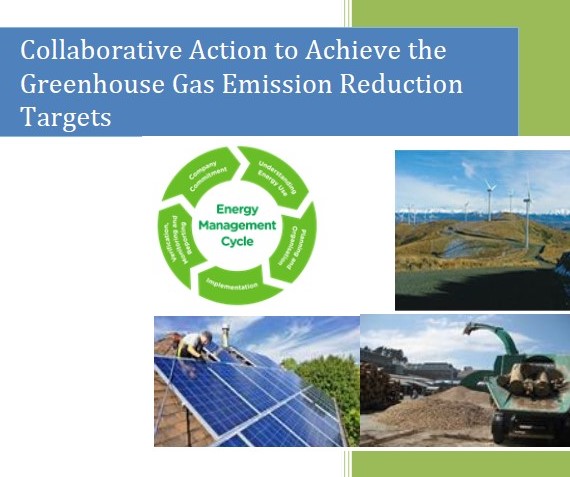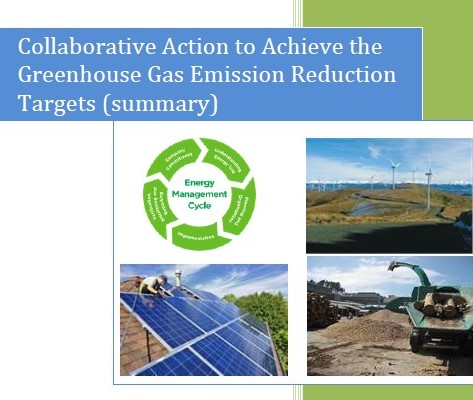Occasional Paper 22: Collaborative action to achieve GHG emission reduction targets
This Collaborative plan of action has been developed collectively by a stakeholders group of 22 industry organisations and territorial councils around the opportunities that renewable and energy efficiency can contribute to achieving the greenhouse gas emission reduction targets announced by Government in Paris in late 2015.
The content of this report is an edited collective view of the individual contributions from the stakeholder organisations from a symposium held in May 2016. The respective information provided by each is in Part 2. The report does not address the adequacy of the targets, or of other business initiatives outside this scope.
The symposium and analysis of the potential domestic mitigation achievable under a Business as Usual Scenario showed that there is already significant mitigation being undertaken by business and communities and that up to about 3 Mt CO2-e per annum GHG mitigation could be achieved by 2050. This level of GHG reduction is around 6% of the 2050 target. However under an encouraged scenario the potential GHG mitigation from the sector could be about 7 Mt CO2-e per annum by 2050 and 4Mt CO2-e by 2030, and up to 16 Mt CO2-e per year by 2050 and 5Mt CO2-e by 2030 under an accelerated scenario.
Under the Accelerated Scenario a reduction of approximately 13Mt CO2-e above the business as usual scenario results in 13Mt CO2-e of international carbon units which would not have to be purchased at a saving to the country of $1-2million per annum.
 Occasional Paper 22 - Action Plan to achieve GHG reduction targets - it not only shows how the greenhouse gas emission reduction targets can be achieved but also outlines the business, regional economic development, societal and environmental outcomes that can be gained. It therefore integrates with the enabling policies being developed by local government such as Wellington and Auckland’s Low Carbon Plans.
Occasional Paper 22 - Action Plan to achieve GHG reduction targets - it not only shows how the greenhouse gas emission reduction targets can be achieved but also outlines the business, regional economic development, societal and environmental outcomes that can be gained. It therefore integrates with the enabling policies being developed by local government such as Wellington and Auckland’s Low Carbon Plans.
Part 2 of the report - the low carbon stakeholder organisations provided summaries of their respective areas of interest and what they expected to be achieved under each of the scenarios. This provides the detail behind the recommendations in Part1.
 Action Plan summary - The collaborative actions developed by the stakeholder group of industry organisations and territorial councils is an indication of how opportunities related to renewable and energy efficiency can contribute to achieving the greenhouse gas emission reduction targets announced by Government in Paris in late 2015. The full report[1] sets out the details of the analysis and is an edited collective view of the contributions from the stakeholder organisations. The respective information provided by each is in a Part 2 report.
Action Plan summary - The collaborative actions developed by the stakeholder group of industry organisations and territorial councils is an indication of how opportunities related to renewable and energy efficiency can contribute to achieving the greenhouse gas emission reduction targets announced by Government in Paris in late 2015. The full report[1] sets out the details of the analysis and is an edited collective view of the contributions from the stakeholder organisations. The respective information provided by each is in a Part 2 report.
Related resources
- Bioenergy Association has continued the work started for this event and have recently published our revised analysis on what GHG emission reductions can be achieved by 2050 from replacing coal and gas with biomass fuel for process heat. See IS48 - GHG reduction using wood energy
- Processing residual waste can lead to a significant reduction in GHGs - See IS47- The role of biogas in transition to low carbon economy
- Actions to reduce use of fossil fuels for process heat and achieve net-zero carbon emissions by 2050 - We have also published lists of what we think needs to be done if the identified targets for GHG emissions reduction are to be achieved by 2050. See IS46 - Actions to reduce use of fossil fuels for process heat
- Actions to maximise reduction of methane emissions from waste and achieve net-zero carbon emissions by 2050 - See IS45 - Actions to reduce methane emissions from waste
